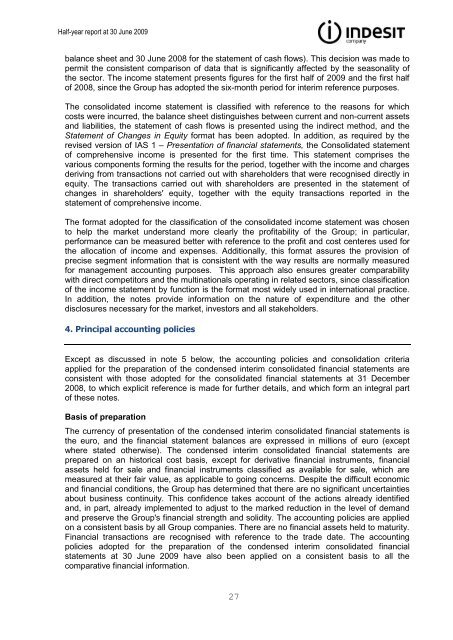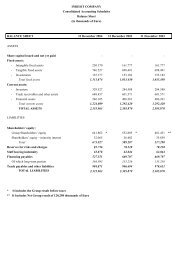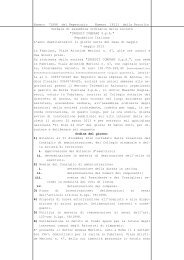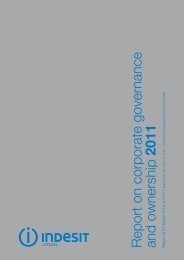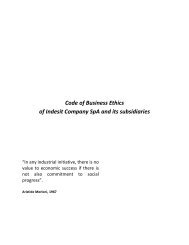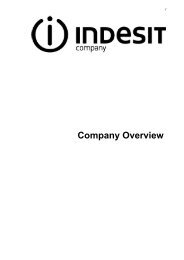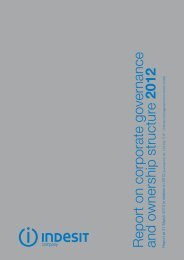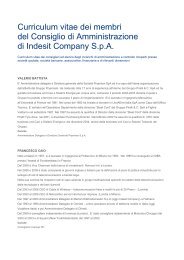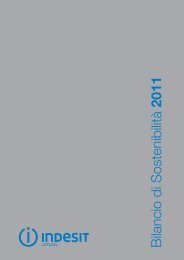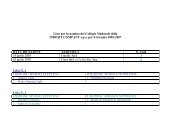2009 1st Half Report - Indesit
2009 1st Half Report - Indesit
2009 1st Half Report - Indesit
You also want an ePaper? Increase the reach of your titles
YUMPU automatically turns print PDFs into web optimized ePapers that Google loves.
<strong>Half</strong>-year report at 30 June <strong>2009</strong><br />
balance sheet and 30 June 2008 for the statement of cash flows). This decision was made to<br />
permit the consistent comparison of data that is significantly affected by the seasonality of<br />
the sector. The income statement presents figures for the first half of <strong>2009</strong> and the first half<br />
of 2008, since the Group has adopted the six-month period for interim reference purposes.<br />
The consolidated income statement is classified with reference to the reasons for which<br />
costs were incurred, the balance sheet distinguishes between current and non-current assets<br />
and liabilities, the statement of cash flows is presented using the indirect method, and the<br />
Statement of Changes in Equity format has been adopted. In addition, as required by the<br />
revised version of IAS 1 – Presentation of financial statements, the Consolidated statement<br />
of comprehensive income is presented for the first time. This statement comprises the<br />
various components forming the results for the period, together with the income and charges<br />
deriving from transactions not carried out with shareholders that were recognised directly in<br />
equity. The transactions carried out with shareholders are presented in the statement of<br />
changes in shareholders' equity, together with the equity transactions reported in the<br />
statement of comprehensive income.<br />
The format adopted for the classification of the consolidated income statement was chosen<br />
to help the market understand more clearly the profitability of the Group; in particular,<br />
performance can be measured better with reference to the profit and cost centeres used for<br />
the allocation of income and expenses. Additionally, this format assures the provision of<br />
precise segment information that is consistent with the way results are normally measured<br />
for management accounting purposes. This approach also ensures greater comparability<br />
with direct competitors and the multinationals operating in related sectors, since classification<br />
of the income statement by function is the format most widely used in international practice.<br />
In addition, the notes provide information on the nature of expenditure and the other<br />
disclosures necessary for the market, investors and all stakeholders.<br />
4. Principal accounting policies<br />
Except as discussed in note 5 below, the accounting policies and consolidation criteria<br />
applied for the preparation of the condensed interim consolidated financial statements are<br />
consistent with those adopted for the consolidated financial statements at 31 December<br />
2008, to which explicit reference is made for further details, and which form an integral part<br />
of these notes.<br />
Basis of preparation<br />
The currency of presentation of the condensed interim consolidated financial statements is<br />
the euro, and the financial statement balances are expressed in millions of euro (except<br />
where stated otherwise). The condensed interim consolidated financial statements are<br />
prepared on an historical cost basis, except for derivative financial instruments, financial<br />
assets held for sale and financial instruments classified as available for sale, which are<br />
measured at their fair value, as applicable to going concerns. Despite the difficult economic<br />
and financial conditions, the Group has determined that there are no significant uncertainties<br />
about business continuity. This confidence takes account of the actions already identified<br />
and, in part, already implemented to adjust to the marked reduction in the level of demand<br />
and preserve the Group's financial strength and solidity. The accounting policies are applied<br />
on a consistent basis by all Group companies. There are no financial assets held to maturity.<br />
Financial transactions are recognised with reference to the trade date. The accounting<br />
policies adopted for the preparation of the condensed interim consolidated financial<br />
statements at 30 June <strong>2009</strong> have also been applied on a consistent basis to all the<br />
comparative financial information.<br />
27


